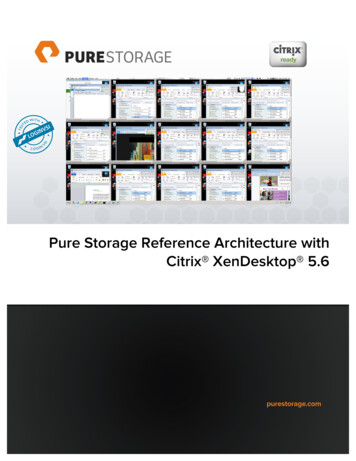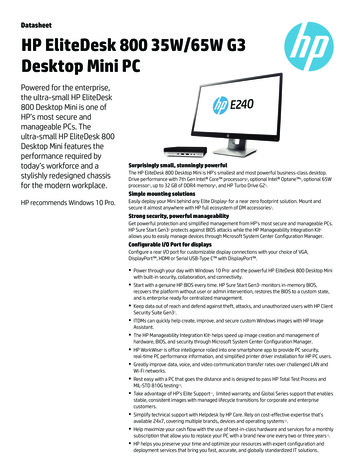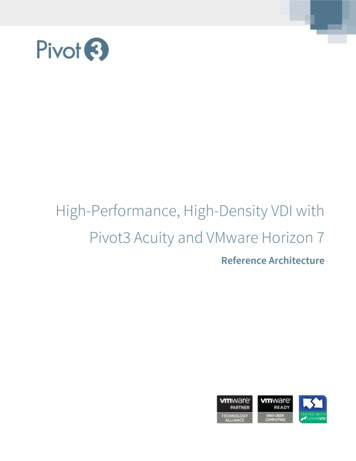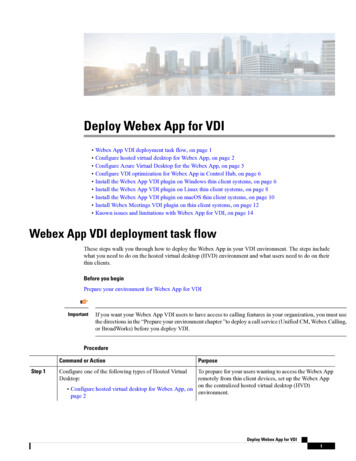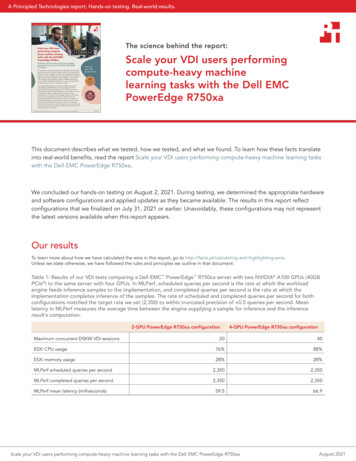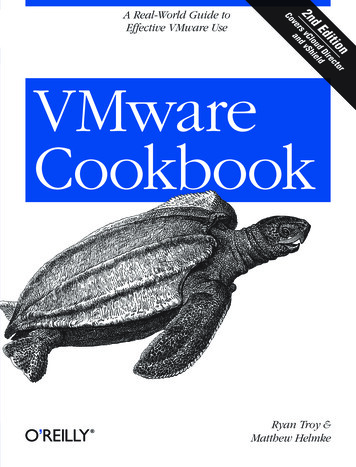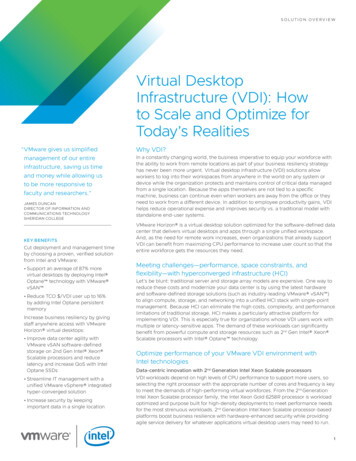
Transcription
SOLUTION OVERVIE WVirtual DesktopInfrastructure (VDI): Howto Scale and Optimize forToday’s Realities“VMware gives us simplifiedmanagement of our entireinfrastructure, saving us timeand money while allowing usto be more responsive tofaculty and researchers.”JAMES DUNCANDIRECTOR OF INFORMATION ANDCOMMUNICATIONS TECHNOLOGYSHERIDAN COLLEGEKEY BENEFITSCut deployment and management timeby choosing a proven, verified solutionfrom Intel and VMware: Support an average of 87% morevirtual desktops by deploying Intel Optane technology with VMware vSAN Reduce TCO /VDI user up to 16%by adding Intel Optane persistentmemoryIncrease business resiliency by givingstaff anywhere access with VMwareHorizon virtual desktops: Improve data center agility withVMware vSAN software-definedstorage on 2nd Gen Intel Xeon Scalable processors and reducelatency and increase QoS with IntelOptane SSDs Streamline IT management with aunified VMware vSphere integratedhyper-converged solution Increase security by keepingimportant data in a single locationWhy VDI?In a constantly changing world, the business imperative to equip your workforce withthe ability to work from remote locations as part of your business resiliency strategyhas never been more urgent. Virtual desktop infrastructure (VDI) solutions allowworkers to log into their workspaces from anywhere in the world on any system ordevice while the organization protects and maintains control of critical data managedfrom a single location. Because the apps themselves are not tied to a specificmachine, business can continue even when workers are away from the office or theyneed to work from a different device. In addition to employee productivity gains, VDIhelps reduce operational expense and improves security vs. a traditional model withstandalone end-user systems.VMware Horizon is a virtual desktop solution optimized for the software-defined datacenter that delivers virtual desktops and apps through a single unified workspace.And, as the need for remote work increases, even organizations that already supportVDI can benefit from maximizing CPU performance to increase user count so that theentire workforce gets the resources they need.Meeting challenges—performance, space constraints, andflexibility—with hyperconverged infrastructure (HCI)Let’s be blunt: traditional server and storage array models are expensive. One way toreduce these costs and modernize your data center is by using the latest hardwareand software-defined storage solutions (such as industry-leading VMware vSAN )to align compute, storage, and networking into a unified HCI stack with single-pointmanagement. Because HCI can eliminate the high costs, complexity, and performancelimitations of traditional storage, HCI makes a particularly attractive platform forimplementing VDI. This is especially true for organizations whose VDI users work withmultiple or latency-sensitive apps. The demand of these workloads can significantlybenefit from powerful compute and storage resources such as 2nd Gen Intel Xeon Scalable processors with Intel Optane technology.Optimize performance of your VMware VDI environment withIntel technologiesData-centric innovation with 2nd Generation Intel Xeon Scalable processorsVDI workloads depend on high levels of CPU performance to support more users, soselecting the right processor with the appropriate number of cores and frequency is keyto meet the demands of high-performing virtual workforces. From the 2nd GenerationIntel Xeon Scalable processor family, the Intel Xeon Gold 6258R processor is workloadoptimized and purpose built for high-density deployments to meet performance needsfor the most strenuous workloads. 2nd Generation Intel Xeon Scalable processor-basedplatforms boost business resilience with hardware-enhanced security while providingagile service delivery for whatever applications virtual desktop users may need to run.1
Virtual Desktop Infrastructure (VDI): How to Scale and Optimize for Today’s RealitiesBERLINER STADTREINIGUNG MAKESGOING GREEN FASTER AND EASIERWhen Europe’s largest municipalsanitation operations company,Berliner Stadtreinigung (BSR),required increasing numbers ofemployees for workplace flexibility,the organization turned to VMwareto implement an appropriate solutionwhile reducing administration costsand improving IT security.The 5,400-strong BSR workforcedesired seamless working; previously,office employees required anunacceptable amount of time to logon and log off due to central serverstored profiles. Also, hardwaredowntime and migration projectscreated high administration effort,and waste collectors relied on handnotation to report problems on routes,causing delays which in turn led tocustomer complaints.HOW THEY DID ITBSR implemented a VMware Horizonvirtual desktop infrastructure with AppVolumes on vSAN hyper-convergedinfrastructure with Intel Xeon Scalableprocessor-powered servers to deliverremote working for employees anda mobile app to waste collectorsvia Workspace ONE, powered byAirWatch technology.These technologies allowed BSRto achieve their goals of greaterworkplace flexibility, decreasedadministrative costs, improvedsecurity, and reduced ecologicalfootprint, all at an affordable cost.Overcome data challenges with Intel Optane Persistent Memory (PMem)Intel Optane PMem revolutionizes memory technology by offering affordable largecapacity and support for data persistence. In this study, adding Intel Optane PMem tothe 2nd Generation Intel Xeon Scalable processor platform expanded memory thatenabled increased CPU utilization to deliver more virtual desktops.Improve storage IO response times with Intel Optane SSD DC P4800X Series andIntel 3D NAND SSDsA VMware vSAN storage caching solution powered by Intel Optane SSDs delivershigh-endurance and low latency to improve performance for vSAN’s write-intensivecache tier. High performing VDI workloads can benefit from the combination of IntelOptane SSDs in the cache tier and Intel 3D NAND SSDs in the capacity tier. Togetherwith VMware vSAN, this storage solution can deliver improved VM performancethrough the combination of lower latency, increased throughput and massive storagecapacity. This can ultimately help to enable up to 33% increase in overall VM densityand storage consolidation in your data center, providing cost-effective scalability withmore VMs at an improved cost/performance.1Reduce complexity through hyper-convergence with the VMware SoftwareSolutions StackMoving to a software-defined data center with VMware increases agility and flexibility,reduces complexity, eases administrative burdens, and delivers high performance forheavy virtual desktop workloads by allowing compute, storage, and networking to beconsolidated in one place. By using this VMware Software Solutions Stack—vSphereas hypervisor, vSAN to pool storage, and Horizon 7 to deliver virtual desktops—organizations can take advantage of single-point management with VMware vCenter and deliver the desktops they need at scale and at pace.VMware vSAN server nodeVMVMvSphere VMvSANIntel Xeon Scalable processorsUpper layersComputeStorageIntel Optane PMemMemoryWrites(expanded memory)ReadsIntel Optane SSD(storage cache)Cache tierCapacity tierIntel 3D NAND SSD(storage capacity)FIGURE 1: How Intel Optane SSDs and persistent memory work togetherSOLUTION OVERVIE W 2
Virtual Desktop Infrastructure (VDI): How to Scale and Optimize for Today’s RealitiesSHERIDAN COLLEGE GIVES STUDENTSTHE MOBILITY THEY CRAVESheridan College in Ontario, Canadawanted to provide its expanding—andincreasingly mobile—student bodywith a common end-user computingplatform they could access usingtheir own devices, from anywhere.Sheridan’s challenges for this projectincluded making the best use ofclassroom and data center space andintegrating sustainability into IT tosupport hundreds of ongoing appliedresearch projects.Scale users easilyA recent study conducted by Principled Technologies found adding Intel OptanePMem alongside small amounts of traditional DDR DRAM enabled this Intel andVMware vSAN solution to support an average of 87 percent more virtual desktops on afour-node VMware vSAN cluster powered by new Intel Xeon Gold 6258R processors,compared to the same cluster with 384GB DDR DRAM alone. While the number of VDIusers depends on CPU capabilities, the study found adding more memory enabledmore efficiency or higher utilization of CPU resources, which led to the increase in VDIusers. The View Planner high memory workload simulates users concurrently runningmultiple office apps and opening multiple web browser windows. Testing with thesedemanding memory requirements means if your users use less-memory-intensiveapps, you could see even higher virtual desktop counts with these configurations.Adopting Horizon VDI on a hyperconverged vSphere and vSANsolution on Intel Xeon Scalableprocessor-powered servers was keyto Sheridan College’s success in thisproject. Students relished the robustmobile learning experience where theycould access their data from laptops,mobile devices, or clients in campuslabs. Hosting virtual desktops on HCIhelped Sheridan maximize data centerspace, delivering linear scalability,improved manageability, and anoverall lower TCO. As studentenrollment grows, administratorscan quickly and easily add newvirtual desktops to support them.300300HOW THEY DID IT280260240Number of VDIusers on an IntelXeon Gold 6258Rprocessor-basedfour-server R DRAM512GB1,024GBIntel OptaneIntel OptanePMem 192GB PMem 192GBDDR DRAMDDR DRAMFIGURE 2: Number of VDI users on a four-server VMware vSAN cluster using Horizon, asmeasured by View Planner. Higher is better. Source: Principled Technologies2Extending memory with Intel Optane PMem, alongside Intel Optane SSDs for storagecaching and Intel 3D NAND SSDs for capacity storage, can help maximize yourorganization’s new hardware investment by consolidating the number of server nodesyou must purchase, store, and manage. Choosing a baseline vSAN configuration withIntel Xeon Gold 6258R processor-based servers and DDR DRAM alone offers strongperformance, with four nodes supporting 160 users. But upgrading that same clusterwith Intel Optane PMem can help you save in different ways, depending on yourspecific virtual desktop needs: If you need to support as many users as possible, upgrading with increasingamounts of Intel Optane PMem can enable the solution to support more VDIsessions cost effectively. For a given number of users, you may be able to consolidate the number ofserver nodes previously required by increasing the Intel Xeon Scalable processorto a higher number of cores/frequency, and by adding Intel Optane PMem toeach node.SOLUTION OVERVIE W 3
Virtual Desktop Infrastructure (VDI): How to Scale and Optimize for Today’s RealitiesTRANSFORMING HEALTHCARE TOFOCUS ON PATIENTS WITH REGIONVÄSTRA GÖTALANDRegion Västra Götaland (VGR), thecounty council governing the territoryVästra Götaland in Sweden, isresponsible for delivering healthcare tonearly one-fifth of Sweden’s population.Existing IT infrastructure was complexand slow, creating huge problemsfor staff and patients, with some staffreporting wait times of up to 45 minutesto log in or access patient records.These frustrations led to valuablemedical staff resigning because they feltunable to provide quality patient carein this environment. VGR sought newIT tools to transform the experience ofemployees and patients alike.Scale TCO in a VDI environment cost effectivelyInvesting in a reliable, high performing VDI environment doesn’t have to blow your ITbudget. By selecting a powerful VMware vSAN cluster based on Intel Xeon Gold 6258Rservers and Intel Optane SSDs and then augmenting the solution with Intel OptanePMem, your organization can support more VDI users for less. Compared to a baselineof 384GB DDR DRAM only that supported 160 users, adding Intel Optane PMemincreased the number of virtual users supported by an average of 87%, to 300 users,while lowering the TCO /VDI user by up to 16%—which means you can support 20%more VDI users per dollar. 1,400VGR stated that the VMware solutionhas delivered 75 percent faster accessto patient records and freed up 10 hoursper month for each person on staff,allowing them to improve patient care.The organization estimates they willget back 350,000 patient care hoursper month—a dramatic leap in patientcare focus for a large segment ofSweden’s population. 1,096.34up to 6%reductionin /VDI 1,000up to 16%reductionin /VDI 800TCO /VDI 979.09300 1,200HOW THEY DID ITWith help from VMware ProfessionalServices, VGR implemented VMwareHorizon desktops with VMware vSANon Intel Xeon Scalable processorpowered servers so clinical staff couldaccess their data from any workspace.350 1,172.36160 600300250200200Usersup to 10%reductionin /VDI150 400100 200500384GBDDR DRAM512GB IntelOptane PMem 192GB DDRDRAM1,024GB IntelOptane PMem 192GB DDRDRAM0FIGURE 3: Total cost per virtual desktop user (in USD) vs. total virtual desktop count.Intel Select Solutions for VMware vSAN: Proven performanceon verified infrastructureReduce your risk and speed your time to solve pressing deployment mandates bychoosing Intel Select Solutions for vSAN, a subset of the certified vSAN ReadyNodes .Comprising verified hardware and software stacks combining Intel Xeon Scalableprocessors, Intel Optane PMem, Intel Optane SSDs, Intel 3D NAND SSDs, and IntelEthernet Network adapters, these performance verified server configurations alloworganizations to deliver joint VMware and Intel solutions to employees and customersfaster—because Intel and VMware have already optimized the solution for a specificworkload or use case.Multiple server vendors deliver these solutions to market through certified channelpartners, meeting or exceeding the minimum performance threshold established byIntel and VMware.SOLUTION OVERVIE W 4
Virtual Desktop Infrastructure (VDI): How to Scale and Optimize for Today’s RealitiesView from the Analysts about VMware VDI SolutionsVMware was named a LEADER in the 2019-2020 IDC Marketscape, “WorldwideVirtual Client Computing Vendor Assessment, for the 5th straight report.3 VMwarewas also named a Leader in The Forrester Wave for Unified Endpoint Management,Q4 2019 with the TOP RANKED solution in the current offering and strategycategories; HIGHEST possible scores in the product roadmap, roadmap execution,and partner ecosystem criteria; and the HIGHEST possible score in the marketpresence category.4 As well, VMware was positioned as a Leader in the 2019 GartnerMagic Quadrant for Unified Endpoint Management Tools for the second consecutiveyear based on Gartner’s evaluation of VMware’s ability to execute and completenessof vision.5SummaryModernizing your infrastructure by moving to the latest software-defined datacenter solutions from VMware and Intel can future proof your data center and bolsterbusiness resiliency in our ever-changing world. Moving to VDI on an Intel-basedVMware vSAN solution and scaling up with new Intel Xeon Gold 6258R processorsand Intel Optane technology can: Improve business resiliency by giving employees anywhere access to the datathey need Enable support for more virtual desktops or consolidate to fewer server nodes tomeet your needs Reduce TCO /VDI user by up to 16% when adding Intel Optane PMem Accelerate applications, reduce transaction costs and improve overall data centerefficiency with Intel Optane SSDs Provide better time to value with a verified foundation for hyper-convergedinfrastructure with Intel Select Solutions Reduce data center complexity and ease management burdensThis future-forward virtual desktop-optimized solution can provide your organizationa verified and trusted way to achieve VDI on HCI at scale to meet your businessobjectives now and provide easy expansion as your needs grow.For more information on the VDI on HCI benchmarking by Principled Technologies,visit here. For more information on implementing Horizon VDI on HCI Select Solutionfor vSAN, visit here. To learn more about the Intel/VMware alliance, visit here.SOLUTION OVERVIE W 5
Virtual Desktop Infrastructure (VDI): How to Scale and Optimize for Today’s Realities1. le/2. In the Principled Technologies white paper areHCI-Intel-Optane-VDI-0420.pdf), the 200 user proof point was obtained by using 512GB Optane PMem 96GB DRAM, using 8GB DIMMS. Principled Technologies also tested 16GB DIMMs and this data referenceis located in the report supplement here: re-HCIIntel-Optane-VDI-science-0520-v2.pdf. We chose to highlight the configuration using the 16GB DIMMS inthis solution brief as 8GB DIMMs are becoming difficult to find and 16GB DIMMS are coming down in price.Three-year TCO estimates as of April 2020, includes hardware, hardware support, software licensing andsupport. Intel Optane persistent memory pricing and DRAM pricing referenced in TCO calculations isprovided for guidance and planning purposes only and does not constitute a final offer. Pricing guidance issubject to change and may revise up or down based on market dynamics. Please contact your OEM/distributor for actual pricing. Software licensing and support includes VMware Horizon 7 Advancedproduction concurrent user licensing at -298798300.html and VMware vSphere Enterprise Plus production concurrent user licensing prise-plus-284281000.html. Performance resultsmay not reflect all publicly available security updates. TCO /VDI user calculated by dividing the 3-yearTCO estimate by the average VDI users per given configuration. VDI users / TCO calculated by dividingthe average VDI users by the three-year TCO estimate per given configuration. For all testedconfigurations, each test was run three times and the average number of VDI users was used.160 User Configuration: Intel Xeon Gold 6258R Processor – 384GB RAM: 4 Node, 2x Intel Xeon Gold6258R Processor, 1x Intel Server Board S2600WFT, Total memory: 384GB DDR4, 12 slots/32GB/2666MT/s, Hyperthreading: Enabled, Turbo: Enabled, Intel VMD: Enabled, Storage (boot): 1x 960GB Intel SSD3520 Series SATA, Storage (cache): 2x 375GB Intel Optane DC SSD P4800X Series, Storage (capacity): 6x2TB Intel SSD DC P4510 Series PCIe NVMe, Network devices: 1x Intel Ethernet CNA XXV710-DA2 at25GbE, Network speed: 25GbE, OS/Software: VMware 6.7.0 U1 and VMware Horizon 7. Testing byPrincipled Technologies. Tested between Feb 2-28, 2020 using VMware View Planner 4.3: 160 highmemory users (2 vCPUs,16GB Memory, 50GB Disk space)200 User Configuration: Intel Xeon Gold 6258R Processor – 512GB DCPMM: 4 Node, 2x Intel XeonGold 6258R Processor, 1x Intel Server Board S2600WFT, Total memory: 512GB Intel Optane DCpersistent memory, 4 slots/128GB/2666 MT/s and 192GB DDR4, 12 slots/16GB/2666 MT/s,Hyperthreading: Enabled, Turbo: Enabled, Intel VMD: Enabled, Storage (boot): 1x 960GB Intel SSD 3520Series SATA, Storage (cache): 2x 375GB Intel Optane DC SSD P4800X Series, Storage (capacity): 6x 2TBIntel SSD DC P4510 Series PCIe NVME, Network devices: 1x Intel Ethernet CNA XXV710-DA2 at 25GbE,Network speed: 25GbE, OS/Software: VMware 6.7.0 U1 and VMware Horizon 7. Testing by PrincipledTechnologies. Tested between Feb 2-28, 2020 using VMware View Planner 4.3: 200 high-memory users(2 vCPUs,16GB Memory, 50GB Disk space)300 User Configuration: Intel Xeon Gold 6258R Processor – 1024GB DCPMM: 4 Node, 2x Intel XeonGold 6258R Processor, 1x Intel Server Board S2600WFT, Total Memory: 1,024GB Intel Optane DCpersistent memory, 8 slots/128GB/2666 MT/s and 192GB DDR4, 12 slots/16GB/2666 MT/s,Hyperthreading: Enabled, Turbo: Enabled, Intel VMD: Enabled, Storage (boot): 1x 960GB Intel SSD 3520Series SATA, Storage (cache): 2x 375GB Intel Optane DC SSD P4800X Series, Storage (capacity): 6x 2TBIntel SSD DC P4510 Series PCIe NVME, Network devices: 1x Intel Ethernet CNA XXV710-DA2 at 25GbE,Network speed: 25GbE, OS/Software: VMware 6.7.0 U1 and VMware Horizon 7. Testing by PrincipledTechnologies. Tested between Feb 2-28, 2020 using VMware View Planner 4.3: 300 high-memory users(2 vCPUs,16GB Memory, 50GB Disk space)3. Source: “IDC MarketScape Worldwide Virtual Client Computing Software 2019-2020 VendorAssessment,” doc #US45752419, January 2020.4. The Forrester Wave is copyrighted by Forrester Research, Inc. Forrester and Forrester Wave aretrademarks of Forrester Research, Inc. The Forrester Wave is a graphical representation of Forrester’s callon a market and is plotted using a detailed spreadsheet with exposed scores, weightings, and comments.Forrester does not endorse any vendor, product, or service depicted in the Forrester Wave. Information isbased on best available resources. Opinions reflect judgment at the time and are subject to change.5. Source: Gartner, Inc., “Magic Quadrant for Unified Endpoint Management Tools,” Chris Silva, et al,August 06, 2019. This graphic was published by Gartner, Inc. as part of a larger research document andshould be evaluated in the context of the entire document. The Gartner document is available uponrequest from VMware. Gartner Disclosure: Gartner does not endorse any vendor, product or servicedepicted in its research publications, and does not advise technology users to select only those vendorswith the highest ratings or other designation. Gartner research publications consist of the opinions ofGartner’s research organization and should not be construed as statements of fact. Gartner disclaims allwarranties, expressed or implied, with respect to this research, including any warranties ofmerchantability or fitness for a particular purpose.VMware, Inc. 3401 Hillview Avenue Palo Alto CA 94304 USA Tel 877-486-9273 Fax 650-427-5001 vmware.com Copyright 2020 VMware, Inc.All rights reserved. This product is protected by U.S. and international copyright and intellectual property laws. VMware products are covered by one or more patentslisted at vmware.com/go/patents. VMware is a registered trademark or trademark of VMware, Inc. and its subsidiaries in the United States and other jurisdictions.All other marks and names mentioned herein may be trademarks of their respective companies. 6/20
Adopting Horizon VDI on a hyper-converged vSphere and vSAN solution on Intel Xeon Scalable processor-powered servers was key to Sheridan College's success in this project. Students relished the robust . 250 up to reduction in VDI up to 1 reduction in VDI up to 10 reduction in VDI 300 350 0 Users C DI 1,400



